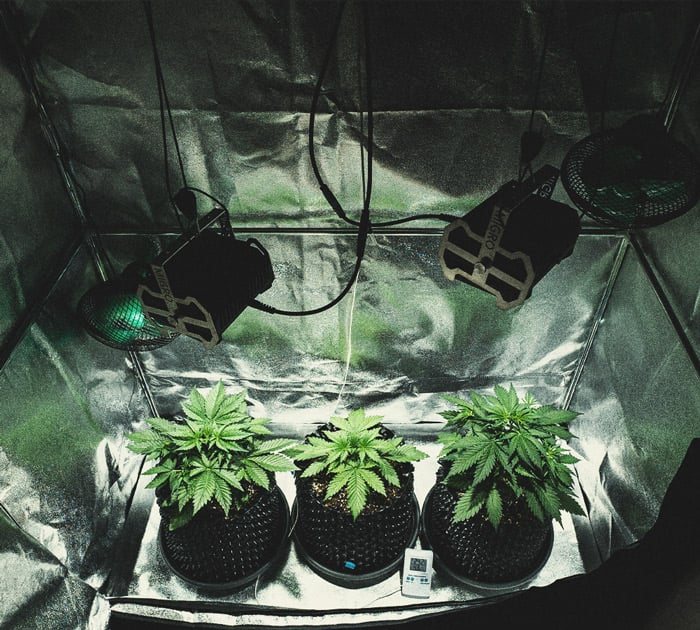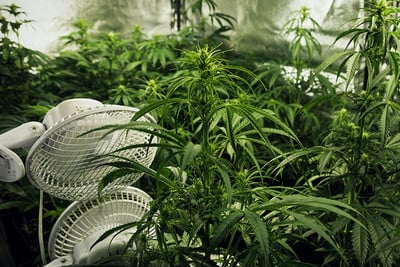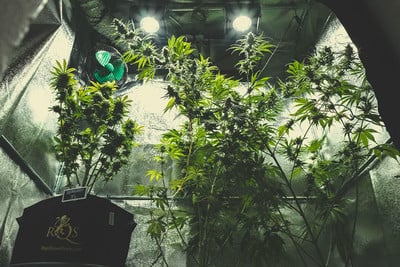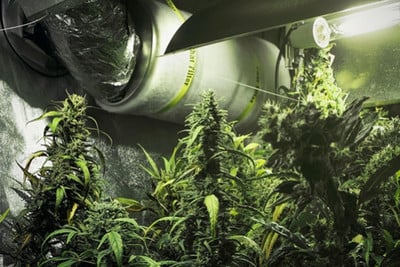.

Everything You Need to Know About Cannabis Grow Tents
If you want to grow weed indoors, and you don't want to dedicate an entire room to it, then your best bet is probably a grow tent. It allows you to optimise your plants' environment, not to mention the cost of your grow, and helps to keep odours contained. Here's everything you need to know about cannabis grow tents.
Contents:
Although cannabis can grow in many conditions, achieving a large crop of the highest-quality bud requires a fairly specific environment. Depending on where you live, your garden might suffice, as could a greenhouse.
However, for many of us, either the weather, the law, or both are against us when it comes to growing cannabis; as result, we need to take things inside. And when you do that, you need to emulate an outdoor environment as best you can.
While you can just set up some lights and hope for the best, a highly controlled environment offers much greater rewards. This is where indoor cannabis grow tents come to the fore.
What Is an Indoor Weed Tent?
A cannabis grow tent is perhaps the most popular type of indoor growing space. It provides a perfect environment for weed to develop, without the need to redesign an entire room for the purpose.
Ranging in size from small enough to fit inside a cupboard to large enough to house majestic sativa specimens, grow tents come in numerous configurations. Much more than just a sheet of plastic, they feature inlets and outlets so you can run power, water, and ventilation into and out of them. Moreover, good grow tents are made of quality materials that help to maintain adequate temperature, humidity, airflow, light exposure, and more.


Why Use a Cannabis Grow Tent?
It’s already somewhat evident why using an indoor grow tent for weed can be a good idea. However, there are a host of reasons why buying (or making) a grow tent is a worthwhile, and indeed almost necessary, endeavour for most indoor growers.
Pros of Using a Marijuana Grow Tent
Ultimately, grow tents create a compact and ideal environment in which to grow cannabis, without permanently taking over a whole room.
Other reasons to use a grow tent include:
- An affordable solution to creating a grow space for cannabis
- Optimised environment improves crop yield and quality

- Insulation saves money on heating
- Helps to prevent infestations

- Keeps dust and dirt out of room
- Helps to maintain stealth by containing heat and smell

- Can work as a place to house mother plants or plants at varying stages of growth


Cons of Using a Marijuana Grow Tent
Compared to the benefits of using a tent to grow weed, the list of drawbacks is rather slim:
- Initial cost can be expensive (depending on what you buy)
- Grow tents still require a degree of space


Ultimately, these cons don’t hold much weight in comparison to the manifold benefits. The reality is that setting up an indoor cannabis grow is relatively expensive with or without a tent—but a tent has the potential to help you yield more. Growing cannabis requires space, with or without a tent, so doing away with one won’t mean that the need for space vanishes.
Where Should You Set Up a Cannabis Grow Tent?
Choosing an appropriate space in which to put your grow tent will help you to determine which specific product to choose. Put it in the right place, and it's incredible. Put it in the wrong place, and it loses many of its benefits, and makes your life a hassle.
Here are some factors worth considering:
- Light proofing: First, grow lights give off a lot of light, and if this spills out of the tent, then it can be incredibly annoying. Second, light coming in at night, when plants are in a phase of darkness, can throw off their internal clock and do a surprising amount of damage. Therefore, you need to choose a space capable of achieving total darkness.
- Airtight: This one is not so important, but it can save you money and effort. First off, an airtight grow space helps to keep odours indoors; second, it allows temperature and humidity to remain more stable. Both of these factors can be optimised by other means, but an airtight space will make your life much easier.
- Air exchange: If you’ve got the budget, then setting up a ventilation system can make a big difference. Primarily, it's great for keeping oxygen, CO₂, and humidity levels suitable. Moreover, instal a carbon filter somewhere along your exhaust system, and you can really help to mitigate those telltale odours.
- Climate control: An airy garage may not be the best space. At least, not without a couple of extras. You’ll need some sort of heating system and a dehumidifier. With these, you can artificially maintain an optimal environment in which your plants can thrive.
- Connectivity: You’ll need to be able to get power and water to your grow tent easily. It’s no good setting it up somewhere only to realise you have to carry litres of water through the house every day, if you can avoid it. Likewise, you probably don’t want wires trailing everywhere, so situating your tent near a plug socket will make your life much easier.
What Factors Are Important When Choosing a Grow Tent?
When choosing a grow tent, there’s a lot to take into account. There are many different options available, and some may be more suitable for your space than others. So let’s break down what to look for to help you make your decision.
Cost
As with all things, there are expensive grow tents, and there are cheaper grow tents. However, you needn’t break the bank to get your hands on a good one. There are some pretty affordable models that offer everything that most growers need.
The cheapest models start at around 100 pounds, while the most expensive can cost several hundred or more. The cheaper tents don’t lack for basic features though, boasting Mylar lining, observation windows, multiple inlets, and tough fabrics.
Before choosing one, research your options and see what the differences between them really are. That way, you can save as much money as possible without ending up with a bad product.
Materials
You have quite a few choices when it comes to materials. First, you want the outer tent to be made of a tough, long-lasting material, such as canvas. But material choice gets really important when you look inside. The inside of a tent is lined with reflective material so that no light is wasted, saving you money and helping you secure a better crop at the same time.
However, the more reflective materials tend to be more expensive. Below are some of your options:
- Aluminium foil (55–60% reflectivity): This is one of the cheapest and most accessible options. It’s a good choice for novice growers who don’t need incredible results—but it will eventually tear. Though the reflectivity isn’t horrible, it won’t deliver the best yields.

- Emergency blankets (70% reflectivity): Alternatively, you can line the space with emergency blankets. These are very cheap and highly reflective. As with foil, though, they crease and tear easily.

- White sheeting (90% reflectivity): This is a great option, as it’s highly reflective. However, it can be a little fiddly to set up inside a tent, which might make it an imperfect choice. Nevertheless, if you can manage it, it works well and is inexpensive.

- Panda film (85–95% reflectivity): This specialist film is black on one side and white on the other. The white side reflects a huge amount of light, is tough, and doesn’t crease. This makes it very good for growing cannabis. The only downside is that it is more expensive compared to other options.

- Orca film (85–95% reflectivity): Working in a similar way to panda film, orca film is the more durable, and more expensive, sibling. If you’re serious about growing and intend to cultivate often, then this will be worth it in the long run. For a first try, though, it’s probably overkill.

- Mylar (90–95% reflectivity): This is the material that most grow tents come installed with, and for good reason. It’s highly reflective and very cheap compared to other options. The only downside is that it’s quite delicate, so be careful with it.


Size
Choosing an appropriate size can be somewhat difficult if you’re new to growing, or if you intend to employ a new method. Different training techniques and/or pot sizes can vastly change the overall size of a crop, as can genetics. Ultimately, you need to figure out how many plants you’re trying to grow per m², and select a tent with appropriate dimensions.
For first-time growers, a grow tent with a floor space of 1m² is enough to grow a decent amount of cannabis. Tents of this size aren’t too expensive (around 100 pounds), which means that finding an affordable lighting setup shouldn't be too difficult either.


Features and Quality
Tents don’t need to be high-tech, but a good one should have several key features. Without these, they can be quite limited.
Here’s what to look out for:
- A sturdy frame with a lot of junctions: You will hang lights and maybe even ventilation systems from your frame. A set of LEDs for a grow of 1m² can weigh as little as 2kg, whereas HPS lighting systems can weigh up to 5kg. Exhaust systems can weigh upwards of 6kg. So to be sure, you’ll want to know that the frame of your grow tent can support at least 12kg of weight, else it might collapse at some point!


- A good number of air-exchange ports: At minimum, you need ports for the exhaust fan to go in and out of, and one lower down through which fresh air will be drawn in. So a good grow tent needs at least three air-exchange ports. Without these, you’ll struggle to give your plants a healthy supply of fresh air.


- A number of entrances: How many zips do you want; just one, or several? Especially with larger tents, being able to access it from multiple sides is really important. Moreover, having transparent observation windows can be very helpful. With these, you needn’t open your tent and disrupt the environment every time you want to take a look at your plants. Just make sure that there’s an opaque covering for this window, to avoid light leaks.


- Odour control: When sealed, a grow tent offers a degree of odour control. That being said, alone it’s not going to totally conceal the telltale scent of a smelly weed grow. If you really want to cover your tracks, it will be necessary to instal a filter in your exhaust system.


- Automation: If you want to automate your grow, you’ll need to source and calibrate timers and pumps by yourself. Grow tents don’t come automated. However, the good news is that most tents are equally suited to being automated.


Hydro or Soil?
If you choose to grow your plants in soil, then they’ll be situated on the floor and should fit comfortably (tip: square pots help to maximise space per m²). Hydroponic setups, however, can require extra space, depending on which you opt for.
It’s possible that extra reservoirs can be set up outside the tent, and piped in via inlets. But if you intend to do this, then you must buy a tent with more than three ports.
That said, ebb and flow systems, deep water culture, and wick systems can be achieved in the same size tent as soil grows. A system such as nutrient film technique, on the other hand, requires a little more space, and might therefore require a bigger tent.
Other Considerations
When you buy a grow tent for cannabis, there are some additional pieces of equipment you’ll need in order to fix everything together. Rigging up lights and exhaust systems requires fixtures, which don’t always come with tents when you buy them.
Useful additions are:
- Cable ties
- Duct tape
- Reflective tape (for sealing gaps around ducting)
- Straps (for heavier setups in bigger tents)
- Power extension cables


Can You Make Your Own DIY Cannabis Grow Tent?
If you don’t fancy the expense of an indoor grow tent, but you want to exploit the benefits, then you can make your own too.
What’s more, it’s not even difficult! So long as you have a little patience, you can create a suitable setup to achieve a quality crop. Note that you will still have to make a small investment to get started; however, you can set up a small DIY grow tent for far less money than buying some of the premium tents on the market.
Buying a Cannabis Grow Tent
Making your own tent is great, and if you’re a dab hand with tools, then there’s little reason not to try it. However, if you just want to get growing and want the best results, then it can sometimes be better to buy a professionally made one and focus on looking after your crop!
If this sounds like a good option for you, we have a range of grow tents to suit growers of different scales and budgets, so take a look!
Indoor Weed Grow Tents: A Perfect Cultivation Solution
If you’re growing marijuana indoors, then using a grow tent is probably the best option. The only time when it is perhaps not is if you can dedicate an entire room to your operation—including lining the walls and hanging lights from the ceiling. And even this isn’t worth it unless you intend to grow a large crop.
Therefore, a grow tent is likely your best bet. There are plenty of options out there, including building your own. So consider what you’ve read here and take a look at some of our more in-depth articles to get an idea of what’s necessary, and see what you can find!








































